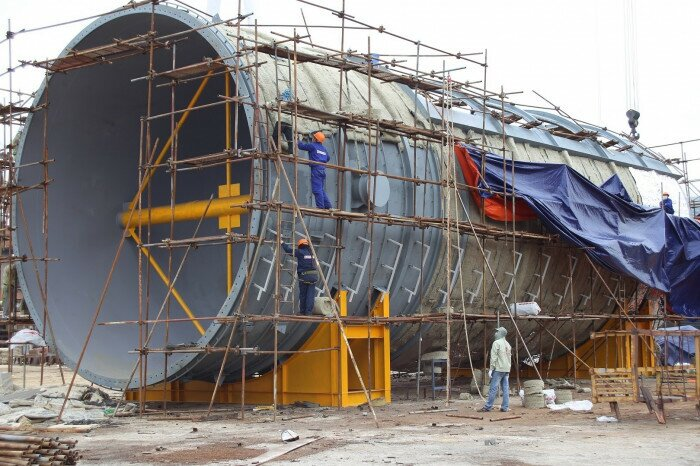Planning Cai Mep wharf area to become an international transshipment gateway
19/04/2023Cai Mep port is planned to be an international transshipment gateway port while Thi Vai wharf area is planned to serve inter-regional socio-economic development.
Cai Mep wharf area has 32 wharfs, Thi Vai wharf area 37 wharfs
According to the “Detailed plan for groups of seaports, ports, wharfs, floating terminals, water areas and water areas in the period of 2021 – 2030, with a vision to 2050” submitted by the Ministry of Transport to the Prime Minister recently, Cai seaport Mep – Thi Vai will be planned to accommodate large tonnage ships to dock in the future.

Specifically, Cai Mep wharf area is planned so that by 2025, the development scale will be from 26 to 27 wharfs with a total length of 6,679 m, throughput capacity from 113.6 million tons to 130.1 million tons. .
By 2030, the development scale of Cai Mep wharf area will be from 31 to 32 wharves with a total length of 8,479 m – 8,879 m, throughput capacity from 145.6 million tons to 170.1 million tons.
For Thi Vai wharf area, there will be a scale of development from 28 to 32 wharfs by 2025, with a total length of 7,966 – 9,095 m. The throughput capacity of the wharf area ranges from 44.7 million tons to 59.2 million tons.
By 2030, it is expected that the development scale of Thi Vai wharf area will be from 33 to 37 wharves with a total length of 9,367 – 10,742 m, throughput capacity from 53 million tons to 71.9 million tons.
The pontoon terminals and cargo mooring areas in Ganh Rai and Cai Mep areas will be maintained in accordance with the current status and gradually relocated when the hard ports meet the demand for loading and unloading or to ensure the development of the port.
In the draft project “Detailed planning for groups of seaports, ports, wharves, buoys, water areas and water areas in the period of 2021-2030, with a vision to 2050”, Cai Mep wharf area is planned with the function of gateway port capacity, international transshipment; with container, general, bulk, liquid/gas berths. Meanwhile, Thi Vai wharf area is planned to serve inter-regional socio-economic development.
Invest in the construction of Cai Mep – Thi Vai fairway into a two-lane channel
To ensure the development goals of the plan, the development of public maritime infrastructure in the area is also phased.
Specifically, by 2025, Cai Mep – Thi Vai channel will be upgraded from buoy number “0” to Cai Mep container terminal.
In which, the channel from buoy number “0” to upstream Cai Mep international container terminal (CMIT) for ships up to 200,000 tons/18,000 Teu offload or larger; The channel section from the upstream Cai Mep international container terminal (CMIT) to the upstream Cai Mep Tan Cang container terminal (TCIT and TCCT) can accommodate ships up to 160,000 tons offload or larger; The section of the channel from the upstream of Tan Cang Cai Mep container terminal (TCIT and TCCT) to Phuoc An launching port for ships of 60,000 tons at full load or larger.
By 2030, dredging the Soai Rap channel for ships from 50,000 tons to 70,000 tons, the Vam Co channel for ships up to 20,000 tons, the channel to ensure the passage of ships of 30,000 tons with the passage from Phuoc An port to the port. Go Dau on Thi Vai River.
In particular, this phase will study and invest in building the Cai Mep – Thi Vai channel into a two-lane channel to receive ships of up to 250,000 tons/24,000 Teu in line with the development of downstream ports.
At the same time, it is proposed to invest in the construction of a ship navigation management system (VTS) in the navigational routes of the group of seaports No. 4.
The connected transport infrastructure is oriented to implement the approved transport plans. In which, priority is given to the development of transport infrastructure connecting to the port.
With infrastructures for the development of Cai Mep – Thi Vai port area, priority is to be given to the construction of the Bien Hoa – Vung Tau expressway, the Bien Hoa – Cai Mep section connecting the Cai Mep – Thi Vai port area, and other ports, routes connecting to ports in Cai Mep – Thi Vai area (Phuoc An bridge connects Cai Mep – Thi Vai inter-port road with Ben Luc – Long Thanh highway).
For inland and coastal waterway infrastructure, focus on renovating and upgrading inland waterway corridors according to planning. In particular, priority is given to renovating and upgrading inland waterways according to the logistics corridor connecting the Southeast and Southwest regions to seaports in Ho Chi Minh City and Ba Ria – Vung Tau, along with the Cambodia international shipping route.
The railway infrastructure is oriented to research and invest in the Bien Hoa – Vung Tau railway connecting with the Saigon – Loc Ninh railway to transport goods from the Southeast region, the Central Highlands and Cai Mep area international transport to Vietnam.
Source: Bao Giao thong
Must Read
You may be interested in


Priority is given to investing in 29 seaport projects with a total capital of over 31 trillion Vietnamese Dong sourced from the state budget

Ba Ria – Vung Tau to become national marine economic hub

Improving the capacity of shipbuilding enterprises, catching the wave of opportunities

Completing negotiations and signing power purchase agreements with 40/40 transitional renewable energy investors

Vietnam expected to emerge as a prominent logistics player in Asia

Freight transportation from Ho Chi Minh City port to Barion Head port

Ho Chi Minh City orients to develop Can Gio “superport”

The maritime industry strives for green transformation








